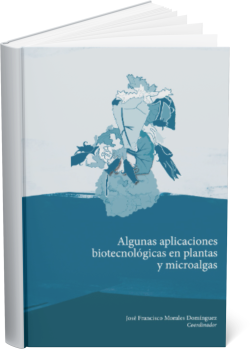SOME BIOTECHNOLOGICAL APPLICATIONS IN PLANTS AND MICROALGAE
Synopsis
Plant biotechnology is a recently developed discipline that could become a crucial tool for addressing the aforementioned problems. In vitro cultivation, conservation, and mass propagation systems for plants can be vital for the conservation and rational use of biodiversity in the short and medium term. Additionally, through in vitro cultivation and production systems, high-value plant metabolites can be obtained without the need to sacrifice plants taken from their natural habitat. On the other hand, genetic engineering techniques allow for the modification or editing of the genomes of plants and related microorganisms, in order to produce high-value chemical compounds in these systems that are not naturally part of their biochemistry. In this way, plants or microorganisms can be converted into "factories" that only require water, minerals, and sunlight to generate high-value products. This is a process that not only does not generate CO2, but also consumes it from the atmosphere. Bioplastics are an example of products that could be produced in this way. On the other hand, these same genetic manipulation tools can generate, much faster than any other technique, crops adapted and capable of producing food and raw materials in the context of climate change. This can be achieved, for example, by locating genes that confer resistance in plants naturally adapted to dry and hot environments, and transferring them to crops of commercial interest. Finally, biotechnology can generate processes that allow us to use living organisms to indicate the presence of potentially toxic agents in the environment, and even use living organisms to clean the environment of these contaminants.
This work, entitled "Some Biotechnological Applications in Plants and Microalgae," presents a current view of many of the recently developed techniques within biotechnology. This is done through a series of chapters prepared by researchers knowledgeable in each topic, from various prestigious institutions. In addition, the chapters are enriched with protocols that can guide those interested in the development and application of these technologies. This work is aimed at undergraduate and graduate students, teachers, and researchers interested in the field of biotechnology applied to plants and algae.
Chapters
-
Introduction
-
Chapter 1 Plant Tissue Culture
-
Chapter 2 Plant Propagation in Temporary Immersion Bioreactors
-
Chapter 3 Analysis of phytochemical compounds
-
Chapter 4 Essential oils as potential nutraceuticals
-
Chapter 5 Green Nanoparticle Synthesis
-
Chapter 6 Plant Phylogenetics Based on Next Generation Sequencing
-
Chapter 7 Phytoremediation
-
Chapter 8 PCR and Oligonucleotide Design
-
Chapter 9 Antimicrobial Peptides from Plants
-
Chapter 10 Gene Expression in Plants; Transcriptomes and miRNAs
-
Chapter 11 Study of abiotic stress in plants.
-
Chapter 12 Genetic transformation of plants
-
Chapter 13 Study and Bioinformatics of Proteins
-
Chapter 14 Study of metagenomes in plants
-
Chapter 15 Lipid Production in Microalgae
-
Chapter 16 Phycoremediation
-
Chapter 17 Genetic transformation of microalgae

Downloads
Published
Series
Categories
License

This work is licensed under a Creative Commons Attribution-ShareAlike 4.0 International License.













